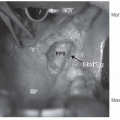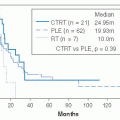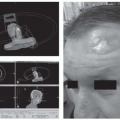Radiologic Imaging Concerns
Jeffrey A. Bennett
The role of imaging for the patient with skin cancer, similar to any other head and neck cancer, is to determine the full extent of the primary tumor, with special attention to bone invasion, perineural spread, and lymphatic spread. Initial inspection of the primary site involves evaluation of the subcutaneous fat, and deep to that, the superficial musculoaponeurotic system (SMAS) (Fig. 23-19). Evaluation of the SMAS and the fat plane deep to it is critical as this is where branches of the facial nerve and trigeminal nerve innervate the muscles of facial expression. Once the SMAS is involved by tumor, the more proximal course of the facial and trigeminal nerves need to be examined to look for more extensive perineural spread (Fig. 23-20).
Imaging helps to determine the extent of cosmetic reconstruction that may be required. It is critical to evaluate bone invasion in this regard. CT is more sensitive than MRI for the detection of cortical bone invasion (Fig. 23-21), but MRI may be better for showing bone marrow extension. Critical areas for cosmesis include the orbits and also the eyelids where basal cell cancer is common1 (Figs. 23-22 and 23-23). When skin cancer invades the calvarium, MRI should be obtained to evaluate the extent of dural or brain involvement (Fig. 23-24).
Perineural spread of skin cancer can occur with squamous cell cancer and basal cell cancer.2 Central perineural spread is more common in basal cell or basaloid squamous lesions,3 and skip lesions are possible. Therefore, the more proximal cranial nerves 5 and 7 should be evaluated with imaging. CT can show perineural spread, but MRI is definitely preferred (Figs. 23-25 and 23-26).4,5,6 A recent study was performed to
determine the accuracy of well-protocoled MRI for the detection of perineural spread of malignancy.7 This study not only found a 100% detection rate, but also showed that MRI underestimates microscopic spread proximal to the Gasserian ganglion.
determine the accuracy of well-protocoled MRI for the detection of perineural spread of malignancy.7 This study not only found a 100% detection rate, but also showed that MRI underestimates microscopic spread proximal to the Gasserian ganglion.
Stay updated, free articles. Join our Telegram channel

Full access? Get Clinical Tree








